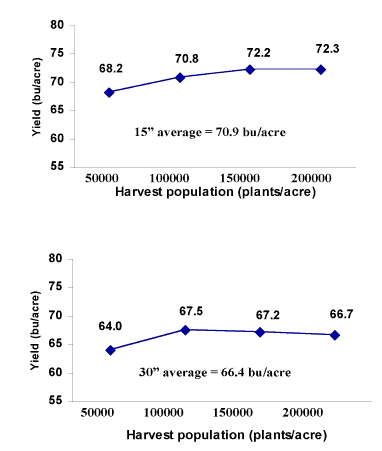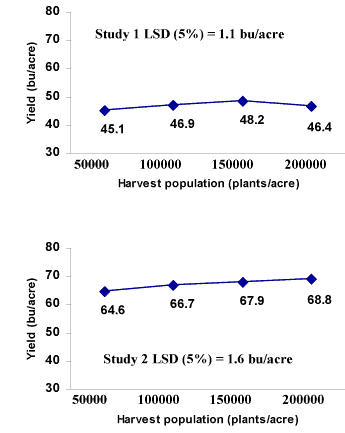Ames, Iowa
April 2, 2007
Source:
Integrated Crop
Management
by Palle Pedersen and Jason De Bruin
Department of Agronomy, Iowa
State University
This article originally
appeared on
pages 98-99 of the IC-498 (4) -- April 2, 2007 issue.
Since 2003, the soybean extension
program has conducted more than two dozen experiments across the
state to evaluate seeding rate recommendations. Extension
researchers have used seeding rates of 75,000, 125,000, 175,000,
and 225,000 seeds per acre and determined how these seeding
rates performed both at early and late planting dates and in 15"
and 30" row spacing. This research was funded by the checkoff
and the Iowa Soybean Association, and new seeding rate
recommendations have been released based on the information
gathered from these experiments.
More seeds for narrow row spacing?
Prior to this study, it was common policy to use seeding
rates of 160,000, 175,000, and 200,000 seeds per acre for 30",
15", and 7.5" row spacing, respectively. Based on research
during the last four years, it was identified that the seeding
rate can be reduced because a uniform stand of 100,000 plants
per acre at harvest is enough to maximize yield and
profitability regardless of row spacing (Figure 1). Previous
recommendations were to increase seeding rate when using narrow
row spacing. However, that is not the case any more, as long as
a planter is used and weeds are managed early. Of course, if you
use a drill, it will take a higher seeding rate because you do
not have the same soil to seed contact with a drill that you
have with a planter.
And do not forget about yield; narrow row spacing (15")
increased yield an average of 4.5 bu/acre compared to 30" row
spacing over the last three years of research in Iowa.
Do seeding rates change for early or late planting dates?
Planting early will consistently increase yield (see the article
"Early planting of soybean is very important" on pages 100-101).
Yield continued to decrease as planting was delayed regardless
of seeding rate. Planting higher populations at later dates did
not improve yield and increased seeding rates were not required
to maximize yield at early planting dates either. Compared to a
final stand of 105,000 and 106,000 ppa, yield was increased
significantly with a final stand of 146,000 ppa in Study 1 and a
174,000 ppa in Study 2 (Figure 2). However, when seed costs are
included, the increased seeding costs offset the value of the
increased yield.
Why does soybean not respond well to seeding rate?
The reason soybean does not respond well to seeding rate is
because the soybean plant can compensate for space. You have
probably all noticed the large bushy plants that occur in areas
of poor plant stand and the skinny plants that occur in
overseeded areas. This is the reason that soybean does not
respond to increased seeding rates. The plant can add branches
when there is space in the canopy. Stacking more plants into an
area will reduce the yield per plant and not increase yield per
acre. The goal is to use a seeding rate that balances individual
plant productivity with canopy productivity.
Factors that influence stand
It is important that we are cautious when we reduce the seeding
rate. Seed has been inexpensive in the past and overseeding has
provided good insurance against poor seedbed conditions and low
establishment rate. However, we can not afford the excessively
high seeding rates anymore. The seeding rate that is required to
reach 100,000 plants per acre at harvest can vary substantially
depending on planting equipment, operator, planting speed, seed
treatment, weed competition, seedling diseases, seeding depth,
and seed quality, just to name a few. In our case, a seeding
rate of 125,000 to 140,000 seeds per acre planted with a planter
was often enough to give us a final stand of approximately
100,000 plants per acre at harvest using good quality seed and
planting in a good seedbed. The only way to determine what
seeding rate is required to achieve 100,000 plants at harvest on
your farm is to take stand counts in the fall. This will help
you zero in on the optimal spring seeding rate for your specific
operation. For more information on stand establishment and plant
mortality rate, see the article in the next newsletter,
How many seeds does it really take to get
100,000 plants per acre at harvest?
 |
|
Figure 1. Yield
response to four harvest plant populations in 15-
and 30- row spacing. Data collected from eight
environments from 2004 to 2006. LSD (5%) for
comparison: row spacing (RS) = 1.3 bu/acre, seeding
rate (SR) = 1.4 bu/acre, and RS x SR = NS. Yield
values |
 |
|
Figure 2. Yield
response for four harvest plant populations averaged
across four planting dates for two studies. Study 1
was conducted at Ames, Crawfordsville, and Nashua
from 2003 to 2005. Study 2 was conducted at De Witt,
Nevada, and Whiting from 2004 to 2006. Yield values
are not significantly different from each other when
the difference between values is less than the LSD.
|
Jason De Bruin is an assistant
scientist with research responsibilities in soybean production.
Palle Pedersen is an assistant professor of agronomy with
research and extension responsibilities in soybean production.
This article originally appeared on
pages 98-99 of the IC-498 (4) -- April 2, 2007 issue. |
|